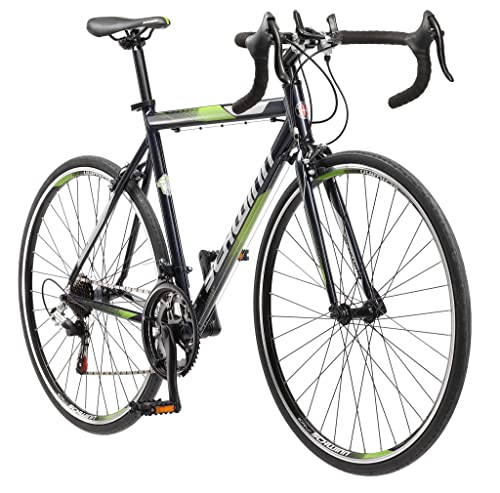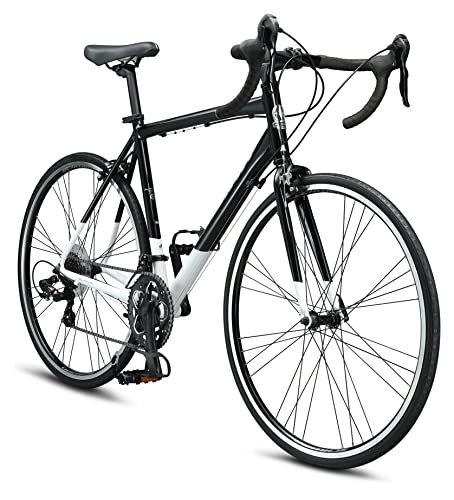Introduction
The road bicycle stands as an iconic symbol of freedom, adventure, and human ingenuity. Its sleek silhouette slicing through the air, propelled by human power alone, embodies the essence of speed and exploration. In this article, we delve into the rich history and enduring allure of the road bicycle, exploring its evolution from a simple mode of transportation to a beloved instrument of fitness and adventure.
Brief History of the Road Bicycle
The history of the road bicycle traces back to the early 19th century when innovations in metallurgy and engineering paved the way for the development of lightweight, two-wheeled vehicles. The earliest incarnations were crude and rudimentary, featuring wooden frames and iron-rimmed wheels. However, it wasn't until the late 1800s that the modern road bicycle began to take shape.
In 1885, the introduction of the "Safety Bicycle" revolutionized cycling with its diamond-shaped frame, chain drive, and pneumatic tires, offering unprecedented stability, comfort, and speed. This innovation democratized cycling, making it accessible to people of all ages and genders, and paved the way for the golden age of cycling in the late 19th and early 20th centuries.
Throughout the 20th century, road bicycles continued to evolve, with advancements in materials, components, and aerodynamics pushing the boundaries of performance. From the introduction of lightweight steel frames to the adoption of aluminum, titanium, and carbon fiber, each era brought new innovations that transformed the riding experience.
The Enduring Appeal of Road Cycling
Despite the passage of time and the rise of alternative forms of transportation, road cycling has retained its timeless appeal. At its core, road cycling is a celebration of human-powered movement, offering a sense of freedom and exhilaration that is unmatched by any other mode of travel.
For many enthusiasts, the road bicycle represents more than just a means of getting from point A to point B—it's a gateway to exploration, self-discovery, and personal challenge. Whether embarking on a solo adventure through winding country roads, joining a group ride with friends, or tackling a grueling mountain climb, road cycling offers endless opportunities for adventure and camaraderie.
In an increasingly fast-paced and digitally connected world, road cycling also provides a welcome escape—a chance to disconnect from screens and distractions, and reconnect with nature, oneself, and the simple joy of pedaling. From the serene beauty of coastal roads to the breathtaking vistas of mountain passes, each ride is an opportunity to immerse oneself in the present moment and savor the purest form of movement.
In the following sections, we'll explore the anatomy of the road bicycle, the health and fitness benefits of road cycling, the joys of exploring the world on two wheels, and the challenges and solutions facing road cyclists today. Join us as we embark on a journey through the fascinating world of road cycling, where every turn of the pedal brings us closer to adventure and freedom.
Anatomy of a Road Bicycle
Understanding the anatomy of a road bicycle is essential for both novice riders and seasoned enthusiasts alike. From the frame to the components and design considerations, every aspect plays a crucial role in determining the performance, comfort, and efficiency of the bike.
Frame: The Foundation of Performance
At the heart of every road bicycle lies its frame—the structural backbone that determines its stability, handling, and responsiveness. Traditionally made from steel, aluminum, titanium, or carbon fiber, modern road bike frames are engineered to strike a delicate balance between strength, stiffness, and weight.
Materials:
Steel: Known for its durability and compliance, steel frames offer a smooth and comfortable ride, making them popular among traditionalists and touring cyclists.
Aluminum: Lightweight and affordable, aluminum frames deliver excellent stiffness and responsiveness, ideal for riders seeking a balance of performance and value.
Carbon Fiber: Renowned for its exceptional strength-to-weight ratio, carbon fiber frames are prized for their stiffness, vibration damping properties, and aerodynamic shaping capabilities, making them the preferred choice for elite cyclists and racers.
Titanium: Combining the best qualities of steel and aluminum, titanium frames offer a unique blend of durability, compliance, and corrosion resistance, albeit at a higher price point.
Geometry:
Endurance: Featuring a more relaxed geometry with a taller head tube and shorter top tube, endurance frames prioritize comfort and stability, making them well-suited for long-distance rides and recreational cyclists.
Race: Characterized by a more aggressive geometry with a lower front end and longer top tube, race frames prioritize aerodynamics and power transfer, making them ideal for competitive cyclists and sprinters.
Components: Gearing, Brakes, and Wheels
A road bicycle's performance is greatly influenced by its components—the gears, brakes, and wheels that work together to propel the rider forward and ensure a safe and efficient ride.
Gearing:
Drivetrain: Comprising the chainrings, cassette, derailleurs, and shifters, the drivetrain determines the bike's gear ratios and shifting performance. Modern road bikes typically feature either a compact or standard crankset paired with a wide-range cassette, providing a versatile range of gears to tackle varied terrain and gradients.
Electronic Shifting: Increasingly popular among high-end road bikes, electronic shifting systems offer precise, reliable, and effortless gear changes at the push of a button, enhancing the overall riding experience and reducing maintenance requirements.
Brakes:
Caliper: Traditional rim brakes provide reliable stopping power and modulation, making them a popular choice among road cyclists for their simplicity and ease of maintenance.
Disc: Growing in popularity, disc brakes offer superior braking performance, especially in wet or adverse conditions, providing greater control and confidence on descents and technical terrain.
Wheels:
Rims: Available in various materials, depths, and profiles, wheel rims significantly impact a bike's aerodynamics, weight, and stability, with carbon fiber rims offering the highest performance but at a premium price.
Tires: The choice of tires can greatly affect a bike's ride quality, grip, and rolling resistance, with wider tires providing enhanced comfort and traction on rough roads while sacrificing aero efficiency.
Design Considerations: Aerodynamics, Weight, and Material Choices
In the pursuit of optimal performance, road bicycle design incorporates various considerations, including aerodynamics, weight, and material choices, to minimize drag, maximize efficiency, and enhance the overall riding experience.
Aerodynamics:
Streamlined tube shapes, integrated cockpit components, and aerodynamic wheel profiles are employed to reduce wind resistance and improve speed, particularly at higher velocities.
Weight:
Striving for lightweight construction, designers employ advanced materials and manufacturing techniques to minimize frame and component weight without compromising strength, stiffness, or durability.
Material Choices:
Selecting the right materials is crucial for achieving the desired balance of performance, comfort, and durability, with carbon fiber offering the highest strength-to-weight ratio but at a premium cost, while aluminum provides a more affordable alternative with slightly higher weight.
Understanding the intricate interplay between these components and design considerations is essential for cyclists seeking to optimize their riding experience and performance on the road. Whether embarking on a leisurely Sunday ride or pushing the limits in a competitive race, a well-designed road bicycle serves as the ultimate tool for exploration and adventure.
Riding Experience
The essence of road cycling lies in the immersive and dynamic riding experience it offers. From the thrill of speed and efficiency to the nuanced art of handling and maneuverability, every aspect contributes to the allure of the open road.
Speed and Efficiency: The Allure of the Open Road
One of the primary attractions of road cycling is its inherent speed and efficiency. With its lightweight frame, aerodynamic design, and smooth-rolling tires, a road bicycle allows riders to cover long distances with minimal effort, making it the preferred choice for those seeking to explore vast landscapes or challenge their personal limits.
Effortless Speed: The streamlined silhouette of a road bicycle cuts through the air with minimal resistance, allowing riders to maintain higher speeds with less exertion compared to other forms of cycling.
Efficiency: The combination of a stiff frame, efficient drivetrain, and low rolling resistance tires maximizes power transfer from the rider to the road, ensuring every pedal stroke propels the bike forward with maximum efficiency.
Freedom and Exploration: Whether cruising along scenic coastal highways or tackling challenging mountain passes, the speed and efficiency of a road bicycle open up a world of possibilities for exploration and adventure, inviting riders to push their boundaries and discover new horizons.
Handling and Maneuverability: Navigating Twists and Turns
In addition to straight-line speed, road cycling demands a high degree of skill and finesse in handling and maneuverability, especially when navigating twists, turns, and varying road conditions.
Responsive Steering: The agile and responsive handling of a road bicycle allows riders to navigate tight corners and technical descents with precision and confidence, making split-second adjustments to maintain control and momentum.
Cornering Technique: Mastering the art of cornering is essential for road cyclists, requiring proper weight distribution, countersteering, and leaning into turns to maintain stability and control while carrying speed through bends.
Adaptability: Whether weaving through urban traffic or negotiating hairpin bends in the mountains, the nimble handling and maneuverability of a road bicycle enable riders to adapt to a wide range of riding environments and conditions, enhancing their overall riding experience and safety.
Comfort and Fit: Finding the Right Balance for Long Rides
While speed and handling are important, comfort and fit are equally crucial aspects of the road cycling experience, particularly for long-distance rides and endurance events.
Ergonomic Design: A well-designed road bicycle incorporates ergonomic features such as a comfortable saddle, ergonomic handlebars, and adjustable components to ensure a proper fit and minimize fatigue during extended periods in the saddle.
Fit Adjustment: Fine-tuning the fit of the bike to match the rider's individual biomechanics and preferences is essential for maximizing comfort and performance, with adjustments to saddle height, reach, and handlebar position optimizing efficiency and reducing the risk of injury.
Vibration Damping: Road bicycles often feature technologies designed to dampen road vibrations and minimize discomfort, such as carbon fiber frames, compliant seatposts, and shock-absorbing handlebar tape, enhancing the overall ride quality and enjoyment on long rides.
Finding the right balance between speed, handling, and comfort is key to unlocking the full potential of the road cycling experience. Whether chasing personal records, exploring new terrain, or simply enjoying the freedom of the open road, road cyclists revel in the dynamic interplay of speed, agility, and endurance that defines their passion for two-wheeled adventure.
Health and Fitness Benefits
Road cycling isn't just about exploring the world on two wheels—it's also a powerful tool for improving physical and mental well-being. From boosting cardiovascular health to building muscle strength and enhancing mental resilience, road cycling offers a myriad of health and fitness benefits that contribute to a happier, healthier lifestyle.
Cardiovascular Health: The Heart-Pumping Benefits of Road Cycling
Few activities rival road cycling when it comes to cardiovascular exercise. The rhythmic pedaling motion engages large muscle groups in the legs, increasing heart rate and promoting circulation throughout the body. As a result, road cycling offers a host of benefits for cardiovascular health:
Improved Heart Health: Regular cycling strengthens the heart muscle, improving its efficiency in pumping blood and delivering oxygen to the body's tissues. This helps reduce the risk of heart disease, stroke, and other cardiovascular conditions.
Lower Blood Pressure and Cholesterol: Cycling helps lower blood pressure and cholesterol levels, reducing the risk of hypertension and atherosclerosis. By promoting healthy blood flow, road cycling supports overall cardiovascular function and reduces the likelihood of arterial blockages.
Enhanced Endurance: Over time, road cycling increases aerobic capacity and endurance, allowing cyclists to sustain higher levels of physical activity for longer periods without fatigue. This not only improves overall fitness but also enhances daily energy levels and stamina.
Muscle Strength and Endurance: Building Power in the Legs
In addition to its cardiovascular benefits, road cycling is an effective way to build strength and endurance in the lower body muscles, including the quadriceps, hamstrings, glutes, and calves. The repetitive motion of pedaling against resistance strengthens and tones these muscles, leading to:
Increased Power and Efficiency: As leg muscles adapt to the demands of cycling, cyclists experience improvements in pedal stroke efficiency and power output. This translates to faster speeds, smoother cadence, and reduced fatigue during long rides or challenging climbs.
Balanced Muscle Development: Road cycling engages a wide range of leg muscles, promoting balanced muscle development and reducing the risk of imbalances or overuse injuries. By strengthening both primary and stabilizing muscles, cycling helps maintain optimal joint function and stability.
Bone Health: Cycling is a weight-bearing exercise that stimulates bone density and growth, reducing the risk of osteoporosis and bone fractures later in life. Regular cycling, particularly at higher intensities or resistance levels, helps maintain bone strength and integrity, especially in weight-bearing joints like the hips and knees.
Mental Well-Being: Stress Relief and Mood Enhancement on Two Wheels
Beyond its physical benefits, road cycling has profound effects on mental health and well-being. Whether riding solo or in a group, the experience of cycling can be deeply therapeutic, offering:
Stress Relief: Cycling provides a welcome escape from the pressures and stresses of daily life, allowing riders to clear their minds, focus on the present moment, and release tension accumulated throughout the day. The rhythmic motion of pedaling and the immersive nature of the riding experience promote relaxation and mental clarity.
Mood Enhancement: The release of endorphins during exercise produces feelings of euphoria and happiness, often referred to as the "runner's high." Road cycling stimulates the production of these feel-good hormones, lifting mood and reducing symptoms of anxiety and depression. Moreover, the sense of accomplishment and satisfaction that comes from completing a challenging ride boosts self-esteem and confidence.
Connection to Nature and Community: Road cycling offers opportunities for connection and camaraderie, whether through shared rides with friends or encounters with fellow cyclists on the road. The sense of belonging to a community and the appreciation of nature's beauty during outdoor rides foster a sense of connection and belonging, promoting mental well-being and social support.
In summary, road cycling is more than just a form of exercise—it's a holistic approach to health and wellness that encompasses physical fitness, mental resilience, and emotional well-being. Whether embarking on a leisurely ride through scenic countryside or pushing the limits in a high-intensity training session, road cyclists reap the rewards of improved cardiovascular health, enhanced muscular strength and endurance, and a greater sense of mental balance and vitality.
Exploring the World on Two Wheels
Road cycling is not merely a means of transportation or exercise—it's a passport to adventure and exploration. Whether embarking on solo journeys of self-discovery, joining group rides for camaraderie and community, or venturing into the wilderness on touring and bikepacking expeditions, road cyclists embrace the world with open arms and spinning wheels.
Solo Adventures: Finding Solitude and Self-Discovery
For many road cyclists, solo riding is a deeply personal and introspective experience—an opportunity to escape the hustle and bustle of daily life and reconnect with oneself and the natural world. Solo adventurers embrace the freedom of the open road, charting their own course and following the whims of curiosity and inspiration.
Solitude and Reflection: Solo rides offer moments of solitude and reflection, allowing cyclists to tune out distractions, quiet the mind, and immerse themselves in the rhythm of the ride. Whether pedaling along deserted country lanes or winding mountain roads, riders find solace in the simplicity of movement and the beauty of their surroundings.
Self-Reliance and Empowerment: Venturing out alone instills a sense of self-reliance and empowerment, as cyclists navigate unfamiliar terrain, overcome challenges, and push their limits without relying on external support. Solo adventures foster independence, resilience, and a deep sense of accomplishment as riders conquer obstacles and discover new strengths within themselves.
Exploration and Discovery: Solo riders have the freedom to explore off-the-beaten-path destinations, uncover hidden gems, and stumble upon unexpected adventures along the way. Whether stumbling upon a quaint roadside cafe, stumbling upon a hidden waterfall, or simply soaking in the sights and sounds of nature, solo cycling adventures are filled with serendipitous moments of discovery and wonder.
Group Rides: Camaraderie and Community on the Road
While solo adventures offer solitude and introspection, group rides bring together like-minded cyclists for camaraderie, companionship, and shared experiences on the road. Whether joining a local club ride, participating in organized events, or forming impromptu pelotons with fellow riders, group rides foster a sense of belonging and connection within the cycling community.
Camaraderie and Friendship: Group rides are a celebration of camaraderie and friendship, as cyclists come together to share their passion for cycling, swap stories, and support each other on the road. Whether chatting side by side during a leisurely pace or pushing each other to new heights during spirited sprints, the bonds forged on group rides are lasting and meaningful.
Motivation and Accountability: Riding in a group provides motivation and accountability, inspiring cyclists to push themselves harder, stay committed to their goals, and achieve new levels of performance. The encouragement and support of fellow riders create a sense of momentum and collective energy, spurring individuals to reach their full potential and beyond.
Safety and Support: Group rides offer safety in numbers, providing an extra layer of protection and support on the road. Whether navigating busy city streets or tackling challenging terrain, cyclists look out for one another, offer assistance in times of need, and ensure that everyone arrives safely at their destination.
Touring and Bikepacking: Adventure Beyond the Beaten Path
For the intrepid explorer, touring and bikepacking open up a world of adventure beyond the confines of paved roads and city streets. Whether traversing rugged mountain trails, crossing vast deserts, or meandering along scenic coastlines, touring cyclists embrace the spirit of exploration and self-reliance as they journey into the unknown.
Freedom and Flexibility: Touring and bikepacking offer unparalleled freedom and flexibility, allowing cyclists to chart their own course, set their own pace, and embrace spontaneity along the way. Whether camping under the stars, staying in cozy bed-and-breakfasts, or seeking refuge in roadside hostels, touring cyclists adapt to the ever-changing landscape with ease and grace.
Immersion in Nature: Touring and bikepacking immerse cyclists in the natural world, offering a close-up glimpse of pristine landscapes, diverse ecosystems, and indigenous cultures. Whether pedaling through remote wilderness areas, traversing national parks, or meandering along scenic byways, touring cyclists forge a deep connection with the land and its inhabitants, gaining a newfound appreciation for the beauty and fragility of the planet.
Self-Sufficiency and Resourcefulness: Touring and bikepacking cultivate self-sufficiency and resourcefulness, as cyclists learn to rely on their own skills, ingenuity, and resilience to overcome challenges and obstacles on the road. Whether repairing a flat tire, purifying water from a mountain stream, or navigating by the stars, touring cyclists embrace the spirit of adventure and adaptability as they journey into the unknown.
In summary, road cycling offers a myriad of opportunities for exploration and adventure, from solo journeys of self-discovery to group rides filled with camaraderie and community, to touring and bikepacking expeditions that take cyclists off the beaten path and into the wild. Whether pedaling through bustling city streets or meandering along remote mountain trails, road cyclists embrace the world with open hearts and spinning wheels, seeking out new horizons and unforgettable experiences along the way.
Challenges and Solutions
Despite its many rewards, road cycling presents its fair share of challenges, from navigating traffic to maintaining bike performance and accessibility. However, with careful planning, preparation, and a proactive approach, cyclists can overcome these obstacles and continue to enjoy the sport safely and sustainably.
Safety Considerations: Sharing the Road with Other Vehicles
One of the most pressing challenges facing road cyclists is sharing the road with other vehicles, including cars, trucks, and pedestrians. Safety considerations are paramount to ensuring a positive and secure riding experience for cyclists of all levels:
Awareness and Visibility: Cyclists should prioritize visibility by wearing brightly colored clothing, using lights and reflective gear, and employing hand signals to communicate with drivers and pedestrians. Increased awareness of one's surroundings and potential hazards can help cyclists anticipate and avoid accidents on the road.
Respect and Cooperation: Sharing the road requires mutual respect and cooperation between cyclists and other road users. Cyclists should adhere to traffic laws, obey signals, and ride predictably to minimize conflicts and promote harmony on the road. Similarly, drivers should give cyclists ample space, yield the right of way when necessary, and exercise caution when passing or overtaking cyclists.
Infrastructure and Advocacy: Investing in dedicated cycling infrastructure, such as bike lanes, paths, and signage, can improve safety and accessibility for cyclists while reducing conflicts with motor vehicles. Advocacy efforts to promote cyclist rights, educate the public about safe cycling practices, and hold policymakers accountable for creating safer road environments are essential for fostering a culture of respect and inclusivity on the road.
Maintenance: Keeping Your Bike in Top Condition
Maintaining a road bicycle in top condition is essential for ensuring optimal performance, safety, and longevity. Regular maintenance and preventive care can help cyclists avoid costly repairs and breakdowns while extending the lifespan of their bikes:
Routine Inspections: Cyclists should conduct regular inspections of their bikes to check for signs of wear, damage, or malfunction. This includes inspecting the frame, drivetrain, brakes, wheels, and tires for any visible defects or abnormalities that may affect performance or safety.
Cleaning and Lubrication: Keeping the bike clean and properly lubricated is essential for preventing corrosion, reducing friction, and prolonging component life. Cyclists should regularly clean their bikes with mild soap and water, remove dirt and debris from moving parts, and apply lubricant to chains, derailleurs, and other mechanical components as needed.
Tire Care: Maintaining proper tire pressure, inspecting for cuts or punctures, and replacing worn tires in a timely manner are critical for ensuring traction, stability, and safety on the road. Cyclists should also check tire tread depth, sidewall integrity, and overall condition to prevent blowouts or flats during rides.
Professional Servicing: While some maintenance tasks can be performed at home, complex repairs and adjustments may require the expertise of a professional bike mechanic. Cyclists should schedule periodic tune-ups and servicing appointments to address more advanced issues, such as wheel truing, brake adjustment, and drivetrain overhaul, and ensure that their bikes are in peak condition for riding.
Accessibility: Overcoming Barriers to Entry in Road Cycling
Accessibility remains a significant challenge for many aspiring road cyclists, particularly those facing barriers related to cost, equipment, skills, and infrastructure. Addressing these barriers and promoting inclusivity within the cycling community is essential for expanding access to the sport and fostering diversity and equity:
Affordability: Cycling can be a costly sport, with bikes, accessories, and gear often priced beyond the reach of many individuals and families. Initiatives such as bike-sharing programs, community bike shops, and subsidized equipment loans can help lower the financial barriers to entry and make cycling more accessible to underserved populations.
Education and Training: Lack of cycling skills and knowledge can deter newcomers from participating in road cycling activities. Providing affordable or free training programs, beginner-friendly rides, and safety workshops can help build confidence, competence, and camaraderie among novice cyclists and ensure that everyone feels welcome and supported on the road.
Infrastructure Improvements: Inadequate cycling infrastructure, including limited bike lanes, unsafe road conditions, and lack of bike-friendly amenities, can discourage individuals from cycling and increase the risk of accidents or injuries. Advocating for improved infrastructure, investing in cycling-friendly urban planning, and engaging with local policymakers and transportation agencies can help create safer, more accessible environments for cyclists of all ages and abilities.
By addressing these challenges and implementing proactive solutions, cyclists can create a more inclusive, equitable, and sustainable cycling culture that benefits individuals, communities, and the planet. Whether advocating for safer roads, sharing maintenance tips, or welcoming newcomers to the sport, every cyclist has a role to play in overcoming obstacles and promoting the joy and freedom of road cycling for all.
The Future of Road Bicycles
As road cycling continues to evolve, the future holds exciting possibilities for technological innovation, sustainability, and demographic shifts within the cycling community. From cutting-edge materials and manufacturing techniques to a growing emphasis on environmental stewardship and inclusivity, the road bicycle of tomorrow is poised to revolutionize the way we ride and interact with the world around us.
Technological Advancements: From Carbon Fiber to Electronic Shifting
The relentless pursuit of performance and efficiency drives ongoing technological advancements in road bicycle design and engineering. Innovations in materials, components, and electronic systems are reshaping the landscape of road cycling, offering cyclists new levels of speed, comfort, and customization:
Carbon Fiber Revolution: Carbon fiber continues to dominate the road bicycle market, offering unparalleled strength-to-weight ratio, stiffness, and vibration damping properties. Advancements in carbon fiber manufacturing techniques, such as automated layup processes and 3D printing, are enabling designers to create lighter, stronger, and more aerodynamic frames and components than ever before.
Electronic Shifting: Electronic shifting systems have revolutionized gear shifting on road bicycles, offering precise, reliable, and effortless gear changes at the push of a button. As technology continues to advance, electronic shifting systems are becoming more affordable, lightweight, and integrated, blurring the lines between mechanical and electronic drivetrains and offering cyclists unprecedented levels of customization and performance.
Integrated Cockpit Systems: Integrated cockpit systems, which combine handlebars, stems, and cables into a single streamlined unit, are gaining popularity among road cyclists for their aerodynamic advantages, clean aesthetics, and improved ergonomics. As manufacturers refine the design and functionality of integrated cockpit systems, they are poised to become standard features on high-end road bicycles, further enhancing the riding experience.
Sustainability Initiatives: Eco-Friendly Materials and Manufacturing Processes
With growing awareness of environmental issues and climate change, sustainability has become a key consideration in road bicycle design and manufacturing. From eco-friendly materials to renewable energy sources, the road bicycle industry is embracing sustainability initiatives to reduce its carbon footprint and promote environmental stewardship:
Recycled Materials: Manufacturers are increasingly incorporating recycled materials, such as recycled aluminum, steel, and plastic, into the production of road bicycles and components. By repurposing waste materials and reducing reliance on virgin resources, cyclists can enjoy high-performance equipment while minimizing their environmental impact.
Biodegradable Components: Biodegradable and compostable materials, such as plant-based resins and natural fibers, are emerging as alternatives to traditional plastics and petroleum-based products in road bicycle manufacturing. These eco-friendly materials offer similar performance characteristics while reducing pollution and resource depletion at the end of their lifecycle.
Energy-Efficient Production: Sustainable manufacturing processes, such as solar-powered factories, energy-efficient machinery, and closed-loop production systems, are helping road bicycle manufacturers minimize energy consumption and greenhouse gas emissions. By investing in renewable energy sources and implementing energy-saving technologies, manufacturers can reduce their environmental footprint and contribute to a greener future for road cycling.
Changing Demographics: The Evolving Landscape of Road Cycling Enthusiasts
Demographic shifts and changing attitudes toward fitness, transportation, and recreation are reshaping the composition of the road cycling community. As cycling becomes more accessible, inclusive, and diverse, the future of road bicycles is characterized by a broader range of participants and perspectives:
Women and Underrepresented Groups: Increasingly, women and underrepresented groups are embracing road cycling as a form of exercise, transportation, and social connection. As cycling brands and organizations prioritize inclusivity and representation, more women and marginalized communities are finding their place in the cycling community and advocating for greater diversity and equity within the sport.
Urban Commuters: With the rise of urbanization and the growing popularity of cycling as a sustainable mode of transportation, road bicycles are becoming essential tools for urban commuters seeking to navigate city streets efficiently and responsibly. As cities invest in cycling infrastructure and promote bike-friendly policies, road cycling is poised to become a mainstream mode of urban mobility for commuters of all ages and backgrounds.
Active Aging Population: As the population ages and life expectancy increases, road cycling is gaining popularity among older adults as a low-impact, joint-friendly form of exercise and recreation. With advancements in bike technology, comfort features, and adaptive cycling equipment, older cyclists can continue to enjoy the benefits of road cycling well into their golden years, promoting active aging and healthy living.
In summary, the future of road bicycles is shaped by a convergence of technological innovation, sustainability initiatives, and changing demographics within the cycling community. From lightweight carbon fiber frames to electronic shifting systems, from recycled materials to biodegradable components, and from women and underrepresented groups to urban commuters and active older adults, road cycling is poised to enter a new era of growth, diversity, and sustainability. As cyclists embrace these trends and embrace the possibilities of the future, the road bicycle will continue to inspire and empower riders of all backgrounds to explore, discover, and thrive on two wheels.
Road Bicycle
As we conclude our exploration of the road bicycle—a timeless companion for fitness and adventure—we are reminded of its enduring appeal and the profound impact it has had on countless lives around the world. From its humble origins in the 19th century to its current status as a symbol of freedom, exploration, and human ingenuity, the road bicycle continues to capture the hearts and imaginations of cyclists of all ages and abilities.
The Enduring Appeal of the Road Bicycle
The road bicycle holds a special place in the hearts of cyclists, embodying the thrill of speed, the joy of exploration, and the sense of freedom that comes from traversing open roads and scenic landscapes. Its sleek silhouette and dynamic performance speak to our innate desire for adventure and self-discovery, inviting us to embark on journeys of both physical and spiritual exploration.
Embracing the Journey and the Destination
For road cyclists, the journey is as important as the destination—a testament to the transformative power of movement, connection, and discovery. Whether embarking on solo adventures of self-discovery, joining group rides for camaraderie and community, or venturing into the wilderness on touring and bikepacking expeditions, road cyclists embrace the journey with open hearts and spinning wheels, savoring every moment and mile along the way.
Looking Ahead to New Horizons in Road Cycling
As we look ahead to the future of road cycling, we are filled with optimism and excitement for the possibilities that lie ahead. From technological advancements and sustainability initiatives to changing demographics and cultural shifts, the road bicycle is poised to enter a new era of growth, diversity, and innovation.
With advancements in materials, components, and electronic systems, road cyclists can expect to enjoy unprecedented levels of performance, comfort, and customization in their equipment. At the same time, a growing emphasis on sustainability and inclusivity promises to make road cycling more accessible, equitable, and environmentally responsible than ever before.
As cyclists, we stand at the threshold of a new frontier in road cycling, where every turn of the pedal brings us closer to adventure, discovery, and connection with the world around us. Let us embrace this journey with open minds and hearts, and let us continue to push the boundaries of what is possible on two wheels. The road ahead is filled with endless possibilities, and the road bicycle will continue to inspire and empower us to explore, dream, and discover the beauty of the world around us.
Outroad Fat Tire Mountain Bike - 26 Inch, 21 Speeds, Sand Trek Bike
Experience ultimate off-road adventure with the Outroad Fat Tire Mountain Bike - 26 Inch, boasting 21 speeds and designed for sand trekking
Product information
$229.98
Product Review Score
4.15 out of 5 stars
71 reviewsProduct links








